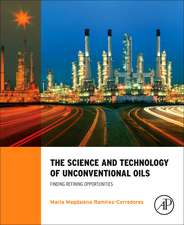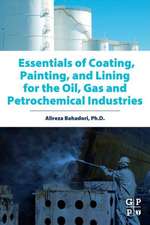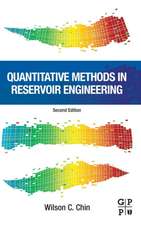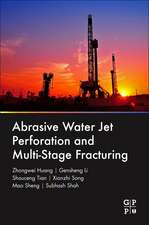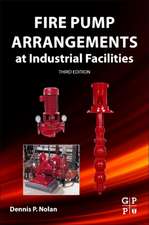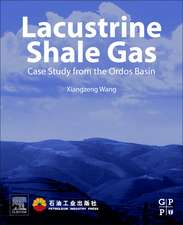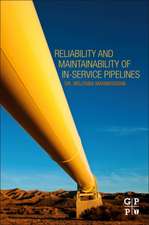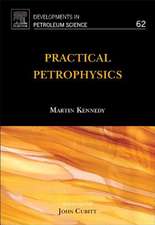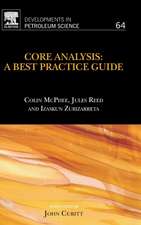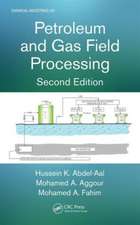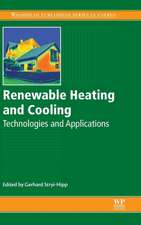Reservoir Formation Damage: Fundamentals, Modeling, Assessment, and Mitigation
Autor Faruk Civanen Limba Engleză Hardback – 28 mar 2023
Additional procedures for unconventional reservoirs get the engineer up to date. Structured to progress through your career, Reservoir Formation Damage, Fourth Edition continues to deliver a trusted source for both petroleum and reservoir engineers.
- Covers new applications through case studies and test questions
- Bridges theory and practice, with detailed illustrations and a structured progression of chapter topics
- Considers environmental aspects, with new content on water control, conformance and produced water reinjection
| Toate formatele și edițiile | Preț | Express |
|---|---|---|
| Hardback (2) | 945.17 lei 5-7 săpt. | |
| ELSEVIER SCIENCE – 23 sep 2015 | 945.17 lei 5-7 săpt. | |
| ELSEVIER SCIENCE – 28 mar 2023 | 1490.59 lei 6-8 săpt. |
Preț: 1490.59 lei
Preț vechi: 2041.90 lei
-27% Nou
Puncte Express: 2236
Preț estimativ în valută:
285.22€ • 310.79$ • 240.34£
285.22€ • 310.79$ • 240.34£
Carte tipărită la comandă
Livrare economică 23 aprilie-07 mai
Preluare comenzi: 021 569.72.76
Specificații
ISBN-13: 9780323902281
ISBN-10: 0323902286
Pagini: 1096
Dimensiuni: 216 x 276 x 58 mm
Greutate: 2.79 kg
Ediția:4
Editura: ELSEVIER SCIENCE
ISBN-10: 0323902286
Pagini: 1096
Dimensiuni: 216 x 276 x 58 mm
Greutate: 2.79 kg
Ediția:4
Editura: ELSEVIER SCIENCE
Public țintă
Reservoir engineers; well designers; production engineers; petrophysicists; completion engineers; petrologists; petroleum engineers; graduate level petroleum engineering studentsCuprins
1. Overview of Formation Damage
Part I. Characterization of Reservoir Rock for Formation Damage. Reservoir Formations, Description and Characterization, Damage Potential, and Petrographics
2. Description and Characterization of Oil and Gas Reservoirs for Formation Damage Potential
3. Petrographical Characteristics of Petroleum-Bearing Formations
Part II. Characterization of the Porous Media Processes for Formation Damage. Porosity and Permeability, Mineralogy Sensitivity, Petrophysics, Rate Processes, Rock-Fluid-Particle Interactions, and Accountability of Phases and Species
4. Alteration of the Porosity and Permeability of Geological Formations- Basic and Advanced Relationships
5. Mineral Sensitivity of Petroleum–Bearing Formations
6. Petrophysical Alterations– Fluid Disposition, Distribution, and Entrapment, Flow Functions, and Petrophysical Parameters of Geological Formations
7. Phase Equilibria, Solubility, and Precipitation in Porous Media
8.Particulate Processes in Porous Media
9. Multi-Phase and Multi-Species Transport in Porous Media
Part III. Formation Damage by Particulate Processes. Single- and Multi-Phase Fines Migration, Clay Swelling, Filtrate and Particulate Invasion, Filter Cake, Stress Sensitivity, and Sanding
10. Single-Phase Formation Damage by Fines Migration and Clay Swelling
11. Multi-Phase Formation Damage by Fines Migration
12. Cake Filtration: Mechanism, Parameters and Modeling
13. Injectivity of the Waterflooding Wells
14. Drilling-Induced Near-Wellbore Formation Damage: Drilling Mud Filtrate and Solids Invasion and Mud cake Formation
15. Reservoir Stress-Induced Formation Damage: Formation Compaction, Subsidence, Sanding Tendency, Sand Migration, Prediction and Control, and Gravel-Pack Damage
Part IV. Formation Damage by Inorganic and Organic Precipitation Processes: Chemical Reactions, Saturation Phenomena, Dissolution, Precipitation, and Deposition
16. Inorganic Scaling and Geochemical Formation Damage
17. Formation Damage by Organic Deposition
Part V. Laboratory Assessment of the Formation Damage Potential. Instrumental Techniques, Testing, Analysis, and Interpretation
18. Instrumental and Laboratory Techniques for Characterization of Reservoir Rock
19. Laboratory Evaluation of Formation Damage
Part VI. Field Diagnosis and Mitigation of Formation Damage. Measurement, Assessment, Control, and Remediation
20. Field Diagnosis and Measurement of Formation Damage
21. Determination of Formation- and Pseudo-Damage from Well Performance- Identification, Characterization, and Evaluation
22. Formation Damage Control and Remediation- Conventional Techniques and Remedial Treatments for Common Problems
23. Reservoir Formation Damage Abatement- Guidelines, Methodology, Preventive Maintenance, and Remediation Treatments
Part VII. Modeling and Simulation of Formation Damage- Prediction of the Near-Wellbore Formation Damage and the Combined Effects of Fluid, Completion, and Formation Damages on Well Performance by Various Modeling and Simulation Approaches and Examples
24. Near-Wellbore Formation Damage by Inorganic and Organic Precipitates Deposition
25.Interactions and Coupling of Reservoir Fluid, Completion, and Formation Damages
26. Formation Damage Simulator Development
27. Model Assisted Analysis and Interpretation of Laboratory and Field Tests
Part I. Characterization of Reservoir Rock for Formation Damage. Reservoir Formations, Description and Characterization, Damage Potential, and Petrographics
2. Description and Characterization of Oil and Gas Reservoirs for Formation Damage Potential
3. Petrographical Characteristics of Petroleum-Bearing Formations
Part II. Characterization of the Porous Media Processes for Formation Damage. Porosity and Permeability, Mineralogy Sensitivity, Petrophysics, Rate Processes, Rock-Fluid-Particle Interactions, and Accountability of Phases and Species
4. Alteration of the Porosity and Permeability of Geological Formations- Basic and Advanced Relationships
5. Mineral Sensitivity of Petroleum–Bearing Formations
6. Petrophysical Alterations– Fluid Disposition, Distribution, and Entrapment, Flow Functions, and Petrophysical Parameters of Geological Formations
7. Phase Equilibria, Solubility, and Precipitation in Porous Media
8.Particulate Processes in Porous Media
9. Multi-Phase and Multi-Species Transport in Porous Media
Part III. Formation Damage by Particulate Processes. Single- and Multi-Phase Fines Migration, Clay Swelling, Filtrate and Particulate Invasion, Filter Cake, Stress Sensitivity, and Sanding
10. Single-Phase Formation Damage by Fines Migration and Clay Swelling
11. Multi-Phase Formation Damage by Fines Migration
12. Cake Filtration: Mechanism, Parameters and Modeling
13. Injectivity of the Waterflooding Wells
14. Drilling-Induced Near-Wellbore Formation Damage: Drilling Mud Filtrate and Solids Invasion and Mud cake Formation
15. Reservoir Stress-Induced Formation Damage: Formation Compaction, Subsidence, Sanding Tendency, Sand Migration, Prediction and Control, and Gravel-Pack Damage
Part IV. Formation Damage by Inorganic and Organic Precipitation Processes: Chemical Reactions, Saturation Phenomena, Dissolution, Precipitation, and Deposition
16. Inorganic Scaling and Geochemical Formation Damage
17. Formation Damage by Organic Deposition
Part V. Laboratory Assessment of the Formation Damage Potential. Instrumental Techniques, Testing, Analysis, and Interpretation
18. Instrumental and Laboratory Techniques for Characterization of Reservoir Rock
19. Laboratory Evaluation of Formation Damage
Part VI. Field Diagnosis and Mitigation of Formation Damage. Measurement, Assessment, Control, and Remediation
20. Field Diagnosis and Measurement of Formation Damage
21. Determination of Formation- and Pseudo-Damage from Well Performance- Identification, Characterization, and Evaluation
22. Formation Damage Control and Remediation- Conventional Techniques and Remedial Treatments for Common Problems
23. Reservoir Formation Damage Abatement- Guidelines, Methodology, Preventive Maintenance, and Remediation Treatments
Part VII. Modeling and Simulation of Formation Damage- Prediction of the Near-Wellbore Formation Damage and the Combined Effects of Fluid, Completion, and Formation Damages on Well Performance by Various Modeling and Simulation Approaches and Examples
24. Near-Wellbore Formation Damage by Inorganic and Organic Precipitates Deposition
25.Interactions and Coupling of Reservoir Fluid, Completion, and Formation Damages
26. Formation Damage Simulator Development
27. Model Assisted Analysis and Interpretation of Laboratory and Field Tests



